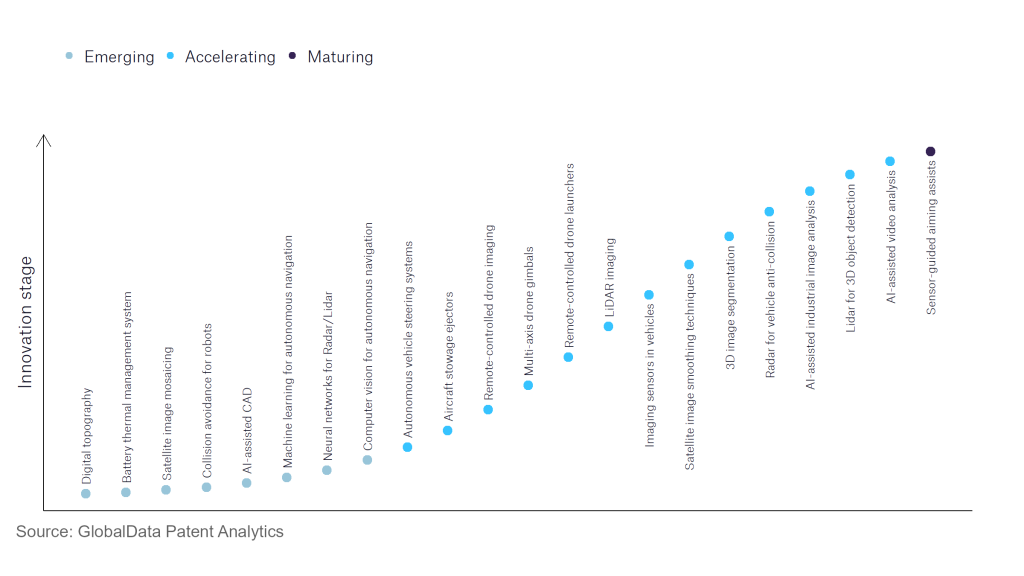The aerospace and defence industry continues to be a hotbed of innovation, with activity driven by developments in artificial technology and machine learning, and growing importance of technologies such as drones, satellite technology and big data. In the last three years alone, there have been over 174,000 patents filed and granted in the aerospace and defence industry, according to GlobalData’s report on Artificial Intelligence in Aerospace, Defence & Security: Imaging sensors in vehicles. Buy the report here.

Discover B2B Marketing That Performs
Combine business intelligence and editorial excellence to reach engaged professionals across 36 leading media platforms.
However, not all innovations are equal and nor do they follow a constant upward trend. Instead, their evolution takes the form of an S-shaped curve that reflects their typical lifecycle from early emergence to accelerating adoption, before finally stabilising and reaching maturity.
Identifying where a particular innovation is on this journey, especially those that are in the emerging and accelerating stages, is essential for understanding their current level of adoption and the likely future trajectory and impact they will have.
180+ innovations will shape the aerospace and defence industry
According to GlobalData’s Technology Foresights, which plots the S-curve for the aerospace and defence industry using innovation intensity models built on over 262,000 patents, there are 180+ innovation areas that will shape the future of the industry.
Within the emerging innovation stage, machine learning for autonomous navigation, battery thermal management system, and satellite image mosaicing are disruptive technologies that are in the early stages of application and should be tracked closely. 3D image segmentation, AV on-board control systems, and lidar for 3D object detection are some of the accelerating innovation areas, where adoption has been steadily increasing. Among maturing innovation areas is sensor-guided aiming assists, which is now well established in the industry.
Innovation S-curve for artificial intelligence in the aerospace and defence industry

Imaging sensors in vehicles is a key innovation area in artificial intelligence
Automotive imaging sensors provide greater awareness for drivers as well as potentially enable autonomous capabilities. For manned vehicles, they provide surround-view images. ‘Imaging sensors’ refers to both the hardware and software involved.
GlobalData’s analysis also uncovers the companies at the forefront of each innovation area and assesses the potential reach and impact of their patenting activity across different applications and geographies. According to GlobalData, there are 50+ companies, spanning technology vendors, established aerospace and defence companies, and up-and-coming start-ups engaged in the development and application of imaging sensors in vehicles.
Key players in imaging sensors in vehicles – a disruptive innovation in the aerospace and defence industry
‘Application diversity’ measures the number of different applications identified for each relevant patent and broadly splits companies into either ‘niche’ or ‘diversified’ innovators.
‘Geographic reach’ refers to the number of different countries each relevant patent is registered in and reflects the breadth of geographic application intended, ranging from ‘global’ to ‘local’.
The largest patent filer in this sector is Intel, which has filed patents on imaging and automated driving to advance automated driving technology. The second largest patent filer is Alphabet, which is heavily involved in the autonomous vehicle sector, and has filed patents across the sector in order to further autonomous driving capabilities. Baidu is the third largest, and is involved in developing autonomous driving capabilities by filing patents for imaging sensors, which would enhance autonomous capabilities and safety.
Seoul Robotics has the greatest application diversity, and is seeking to commercialise autonomous vehicles by increasing sensor capabilities in the surrounding environment as well as within vehicles – the company is developing a control tower, which can give vehicles greater awareness of surroundings. Luminar Technologies has the second greatest application diversity and is filing patents for LiDAR, which will give better situational awareness and theoretically provide better safety features than existing computer vision technology. Seoul Robotics also has the largest geographic diversity, solidifying its market position. The second place is occupied by PACCAR technology, which aims to bring autonomous technology to trucks, providing potential supply chain solutions.
Whilst autonomous vehicles are not yet widespread, the technological advancement as well as variety of companies investing in the technologies will advance the technology in coming years.
To further understand how artificial intelligence is disrupting the aerospace and defence industry, access GlobalData’s latest thematic research report on Thematic Research: AI in Defense.
Data Insights
From

The gold standard of business intelligence.
Blending expert knowledge with cutting-edge technology, GlobalData’s unrivalled proprietary data will enable you to decode what’s happening in your market. You can make better informed decisions and gain a future-proof advantage over your competitors.




